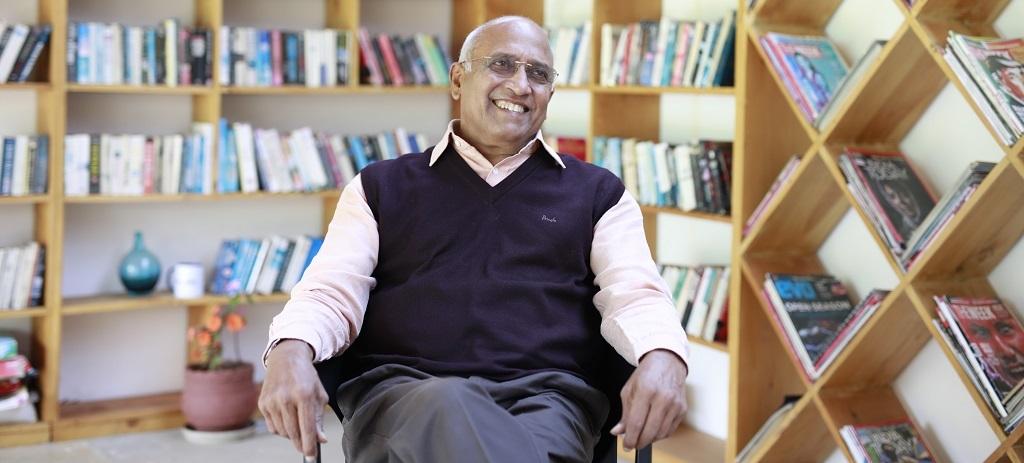Tracking The Journey Of Rakesh Sharma: India's Pioneer In Space

Table of Contents
Rakesh Sharma's Early Life and Training
Rakesh Sharma's path to becoming India's pioneering astronaut began with a fascination for flight and a relentless pursuit of excellence. Born in Patiala, Punjab, he displayed an early aptitude for academics and a strong interest in aviation. His educational journey laid a solid foundation for his future endeavors:
- Educational Background: He pursued his education at St. Edward's School, Shimla, and later graduated from the prestigious National Defence Academy (NDA), Khadakvasla, before receiving his commission in the Indian Air Force. His pilot training honed his skills and prepared him for the demanding challenges ahead.
- Selection Process: The selection process for the Soyuz T-11 mission was incredibly rigorous. From a pool of highly qualified Indian Air Force pilots, Sharma was chosen based on his exceptional flying skills, physical fitness, mental fortitude, and scientific aptitude. The process included extensive physical and psychological testing, ensuring only the most capable candidates were selected.
- Training Regimen: Once selected, Sharma underwent a grueling training program in the Soviet Union. This involved a range of specialized training modules:
- Flight Simulation: Extensive hours were spent in simulators, replicating the conditions of spaceflight and preparing him for potential emergencies.
- Survival Training: This crucial training prepared him to cope with the challenges of a potential emergency landing or survival in harsh environments.
- Cosmonaut Training: This involved studying the intricacies of spacecraft operations, scientific experiments, and living in a microgravity environment.
- Essential Skills: The mission demanded a unique blend of skills – exceptional piloting expertise, scientific knowledge, problem-solving abilities under pressure, and unwavering resilience in the face of extreme conditions.
The Historic Soyuz T-11 Mission
Launched on April 3, 1984, the Soyuz T-11 mission marked a watershed moment for India. This collaborative endeavor with the Soviet Union saw Sharma, along with two Soviet cosmonauts, embarking on a journey to the Salyut 7 space station.
- Mission Objectives: The primary objectives included conducting a variety of scientific experiments in microgravity, observing Earth from space, and testing equipment for future space missions.
- Launch and Duration: The mission launched from the Baikonur Cosmodrome in Kazakhstan and lasted for eight days.
- Experiments Aboard Salyut 7: While aboard the Salyut 7 space station, Sharma participated in several experiments focusing on remote sensing, materials science, and human physiology in space. The data collected proved invaluable to scientific research.
- Challenges Faced: The mission was not without its challenges. The crew faced the physical and psychological strains of spaceflight, including adaptation to microgravity, confined living conditions, and the ever-present risk of technical malfunctions.
- International Collaboration: The success of the Soyuz T-11 mission underscored the importance of international cooperation in space exploration. The collaboration between India and the Soviet Union served as a model for future joint ventures.
Rakesh Sharma's Contributions and Legacy
Rakesh Sharma's mission extended far beyond the eight days spent in space. His journey instilled immense national pride and inspired a generation of Indian scientists and engineers.
- Scientific Advancements: The scientific data gathered during the mission contributed significantly to our understanding of various scientific phenomena in a microgravity environment. The experiments conducted on Salyut 7 yielded valuable insights across multiple scientific disciplines.
- Technological Impact: The mission spurred advancements in remote sensing technologies, contributing to improved capabilities in Earth observation and resource management.
- Inspiring Future Generations: Rakesh Sharma’s journey became a powerful symbol of what is possible, inspiring countless young Indians to pursue careers in science, technology, engineering, and mathematics (STEM).
- Post-Mission Career: Following his space mission, Sharma continued to contribute significantly to the aerospace field, holding various positions within the Indian Air Force and later contributing to India's space program in different capacities.
Remembering Rakesh Sharma: A National Hero
Rakesh Sharma’s achievement transcended the realm of space exploration, solidifying his place as a national hero in India.
- Awards and Recognitions: He received numerous awards and accolades for his contributions, including the Ashoka Chakra, India's highest peacetime military decoration.
- National Hero Status: Sharma's mission became a symbol of India’s growing capabilities and its aspirations in the global space arena. His image resonated with national pride and inspired a generation.
- Memorable Moments: His famous quote upon his return, "From up there, the borders are not visible," served as a powerful message of unity and global perspective.
- Long-Term Impact: His legacy continues to inspire India's ongoing space endeavors and serves as a testament to the nation's commitment to scientific advancement.
Conclusion: Celebrating the Journey of India's Space Pioneer
Rakesh Sharma's journey to space remains a pivotal moment in Indian history. His courage, dedication, and scientific contributions have left an indelible mark on India's space program and inspired generations to reach for the stars. His mission stands as a testament to human ambition and the power of international cooperation in pushing the boundaries of scientific exploration. Learn more about the inspiring journey of Rakesh Sharma and discover the future of Indian space exploration. Explore the legacy of India's first man in space and the continued achievements of the ISRO. Remember the pioneering spirit of Rakesh Sharma and the ongoing quest for knowledge in Indian space research.

Featured Posts
-
 Bitcoin Seoul 2025 Networking And Innovation In Asia
May 09, 2025
Bitcoin Seoul 2025 Networking And Innovation In Asia
May 09, 2025 -
 Madeleine Mc Cann Case Update 23 Year Old Presents New Dna Evidence
May 09, 2025
Madeleine Mc Cann Case Update 23 Year Old Presents New Dna Evidence
May 09, 2025 -
 Colapinto Sponsors Hot Mic Revelation F1 News You Wont Believe
May 09, 2025
Colapinto Sponsors Hot Mic Revelation F1 News You Wont Believe
May 09, 2025 -
 Prisao De Suspeita Que Se Apresenta Como Madeleine Mc Cann Na Inglaterra
May 09, 2025
Prisao De Suspeita Que Se Apresenta Como Madeleine Mc Cann Na Inglaterra
May 09, 2025 -
 Chinas Impact On Luxury Car Sales Bmw Porsche And Beyond
May 09, 2025
Chinas Impact On Luxury Car Sales Bmw Porsche And Beyond
May 09, 2025
Latest Posts
-
 High Potential Finale Two Actors From 7 Year Old Abc Series Reunite
May 09, 2025
High Potential Finale Two Actors From 7 Year Old Abc Series Reunite
May 09, 2025 -
 High Potential Analyzing The Risky Season 1 Finale And Its Success
May 09, 2025
High Potential Analyzing The Risky Season 1 Finale And Its Success
May 09, 2025 -
 The Impact Of High Potentials Season 1 Finale On Abc
May 09, 2025
The Impact Of High Potentials Season 1 Finale On Abc
May 09, 2025 -
 7 Year Reunion High Potential Finale Features Familiar Faces
May 09, 2025
7 Year Reunion High Potential Finale Features Familiar Faces
May 09, 2025 -
 High Potentials Bold Finale Why Abc Was Impressed
May 09, 2025
High Potentials Bold Finale Why Abc Was Impressed
May 09, 2025
